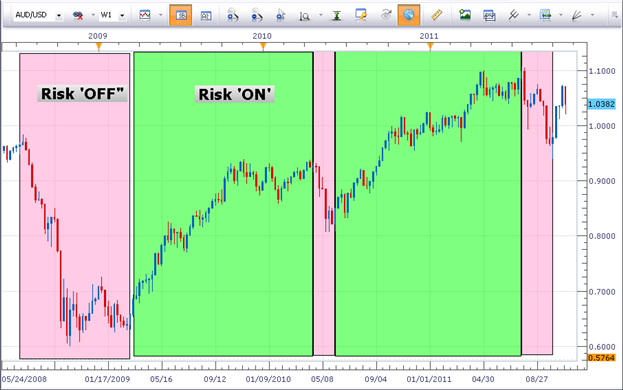The market sentiment seems to flip flop back and forth on a daily basis between a “Risk On” and a “Risk Off”. Reading Risk Sentiment is as simple as following the direction of the US Stock Market.
Each day, it seems a new rumor is produced and the stock markets shifts accordingly. The seesaw action can take a toll on a trader’s emotions.
One way to gauge an underlying trend in the market is through the risk appetite of investors. The benefit of understanding the mood of the market is it allows you to align your trades in the direction of the market sentiment.
When you see the stock market increase significantly, that is an indication that risk is “on”. A risk “on” environment is a mood of the market where investors feel good about the future prospects of the economy. Therefore, they take their capital and speculate in the stock market and high yielding instruments. This generally increases the value of the stock market and high yielding currencies which lately are the Australian Dollars (AUD) and New Zealand Dollars (NZD).
At the same time, low yielding instruments tend to gain less on a relative basis or possibly even lose value. Low yielding currencies tend to be sold to fund the purchase of a higher yielding currency. This selling of a low yielding currency while simultaneously buying a high yielding currency is called the Carry Trade. So an effect of a risk “on” sentiment is an increase in the stock market and demand for high yielding currencies. As a result the Carry Trade strategy tends to perform well. (See additional resources below for more information on the Carry Trade Strategy.)

(Created by J. Wagner)
In the chart above, since the AUD has historically been a high yielding currency, when the risk sentiment was ‘ON’ (Green shaded areas) the AUD/USD exchange rate was likely to rise and the carry trade strategy worked well. When the risk sentiment turned ‘OFF’ (pink shaded areas) the AUD/USD exchange rate tended to fall and the carry trade strategy would not have performed inconsistently.
When you see the stock market fall like we did earlier this week that is labeled as risk “off” in the media. That means investors and traders are averse to risk…they want to avoid risk and risky instruments. Therefore, the investors pull their money out of stocks by selling their shares and sell their risky instruments like high yielding currencies. In a risk “off” market mood, the carry trade does not work. Although a trader is gaining a daily dividend, the movement of the exchange rates is so adverse that is wipes out any interest gains.
In a risk “off” environment, traders are better served buying safe haven currencies like the US Dollar (USD) or Japanese Yen (JPY). (Until August 2011, the Swiss Franc was also considered a safe haven currency, but the recent intervention by the Swiss National Bank is trying to curtail the buying of the Franc.)
The risk assets like the US Stock market and high yielding currencies like the AUD are near resistance levels. This may mean a return to risk aversion and a selloff in the stock market and AUD/USD.
Next: How to Identify Positive Risk-Reward Ratios with Price Action (15 of 50)
Previous: Manage Stops Like a Professional: Price Channels
---Written by Jeremy Wagner, Lead Trading Instructor, DailyFX Education
To contact Jeremy, email jwagner@dailyfx.com. Follow me on Twitter at @JWagnerFXTrader.
To be added to Jeremy’s e-mail distribution list, send an email with the subject line “Distribution List” to jwagner@dailyfx.com.




